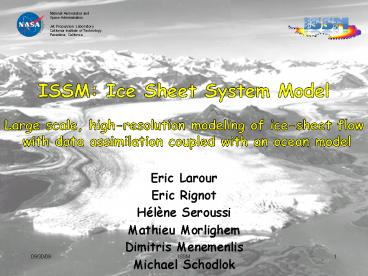Eric Larour - PowerPoint PPT Presentation
1 / 15
Title: Eric Larour
1
Eric Larour Eric Rignot Hélène Seroussi Mathieu
Morlighem Dimitris Menemenlis Michael Schodlok
09/30/09
ISSM
1
2
Outline
- Introduction
- Current Implementation and results
- Future capabilities.
- Challenges and Perspectives
Date
ISSM Presentation
2
3
1. Introduction
- ISSM (Ice Sheet System Model) initiated from JPL
RTD effort (Larour, PI) and NASA IDS (Rignot,
PI). - ISSM is now funded by NASA MAP (Modeling and
Prediction) (Rignot, PI). - Only and first ice sheet modeling effort (with
PISM) funded by NASA/MAP. - ISSM is a JPL/UCI collaboration to develop
large-scale, high-resolution ice-sheet modeling
with remote sensing data assimilation, coupled
with an ocean model. - Data assimilation includes InSAR, GRACE and
altimetry (ATM, ERS, Icesat). - Ocean model is JPL/MIT ECCO2 derived from the
MIT/GCM. - ISSM offers large-scale capability (Antarctica),
multi-scale (km glacier to 100-km ice sheet
proper), multi-model (2d, 3d, 2d/3d coupled, full
Stokes).
Date
ISSM Presentation
3
4
2- Current implementation.
- 2D-3D higher-order modeling Hutters SIA,
MacAyeals shelfy-stream, Pattyns higher order
3D, full Navier-Stokes 3D. - Multi-model different models are connected using
Rigid Body Motion connectors, or method of
penalties. - Multi-scale anisotropic mesh adaptation, Yams
(INRIA, Pascal Frey).
09/30/09
ISSM
4
5
Thermal regime
- Thermal regime steady-state transient.
- Advection conduction, no approximation.
- SUPG stabilization.
- Melting is a by product of thermal modeling using
- penalties.
09/30/09
ISSM
5
6
Spatial resolution and geographic coverage
- Large scale capability
- 5 million dof on 256 CPU cluster (shared or
distributed memory). - Using Yams -gt 1 km resolution on Antarcticas ice
streams, lt 1km resolution on Greenland basins,
with 10 vertical layers.
09/30/09
ISSM
6
7
Data assimilationBasin level
- Higher-order data assimilation MacAyeal, Pattyn
and Stokes formulations at the basin level. - MacAyeal and Pattyn at the continental scale.
2-D. MacAyeal formulation. Bedrock friction
(m.s1/2). PIG.
Modeled velocity (m/a). 79N.
3-D. Stokes formulation. Bedrock friction
(m.s1/2). PIG.
3-D. Pattyn formulation. Bedrock friction
(m.s1/2). PIG.
Bedrock friction (m.s1/2). 79N.
09/30/09
ISSM
7
8
Data assimilationContinental scale Greenland
- Model
- - Data assimilation for basal drag, using surface
velocity from InSAR (Rignot) balanced
velocities (Bamber 2001) - Run statistics
- -128 CPUS cluster. 12 h computation.
- 500 m resolution at basins , 10 km inland.
- 10 vertical layers.
09/30/09
ISSM
8
9
Data assimilationContinental scale Antarctica
- Model
- - Data assimilation for basal drag, using surface
velocity from InSAR (Rignot). - Run statistics
- -128 CPUS cluster. 18 hr computation.
- - 1.5km resolution at basins, 10 km inland.
- 10 vertical layers.
09/30/09
ISSM
9
10
ISSM ECCO2
- ECCO2 framework (using MIT GCM) is used to
provide a coupling with the ocean. - melting under ice shelf cavities and at ice front
implemented by Schodlok, 2009. - Other processes are being implemented
(sub-glacial discharge, submarine melting of
calving faces (Rignot et al., 2009)).
09/30/09
ISSM
10
11
Sensitivity analysis
- Dakota in embedded mode (Sandia National Lab)
- Local reliability methods
- Monte-Carlo (Latin Hypercube)
- Parameter studies
- Optimization
09/30/09
ISSM
11
12
3. Future capabilities.
- Moving boundary conditions
- Grounding line dynamics implemented at the 100 m
spatial scale - Calving law
- Evolutionary model for basal drag combining
hydrological modeling and data assimilation
09/30/09
ISSM
12
13
4. Challenges and perspectives.
- Outstanding challenges for ice sheet modeling
- - Prognosis Even with data assimilation and
control, these numerical models remain tunable,
diagnosis models, not prognosis models. - - Glacier thickness We need the depth below sea
level, bed slope, and basic shape of glacier
troughs of all major Greenland glaciers. We need
major Cresis/Icebridge campaigns for thickness
using radar and other tools where radar does not
work (gravity?). Higher-resolution products
remain TBD - - Time series of ice velocity (InSAR and others)
and ice surface elevation (Icesat, ATM, Cryosat)
remain fundamental observables for constraining
ice flow models. - - Ice-ocean interactions are an
important/dominant control of glacier changes. We
need improved fjord bathymetry near glacier
fronts to better constrain ice-sheet/ocean
coupled models.
09/30/09
ISSM
13
14
Date
ISSM Presentation
14
15
15



















![[PDF READ] Free The Life and Sort of Death of Eric Argyle (M PowerPoint PPT Presentation](https://s3.amazonaws.com/images.powershow.com/10091816.th0.jpg?_=202408031212)










